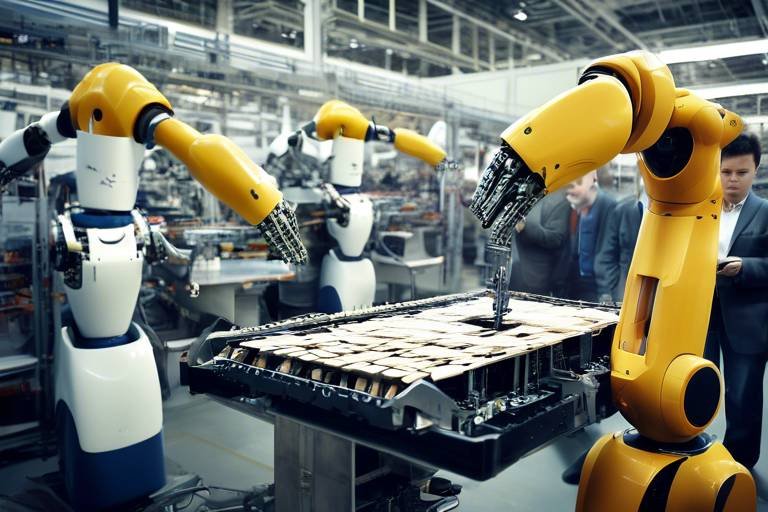How Robots are Changing the Manufacturing Industry?
The manufacturing industry is undergoing a remarkable transformation, thanks to the rapid advancement of robotic technology. Imagine stepping into a factory where robots seamlessly collaborate with human workers, enhancing productivity and efficiency. This isn't just a futuristic dream; it's happening right now! The integration of robots into manufacturing processes is revolutionizing how products are made, and the implications are profound. From automotive assembly lines to electronics production, robots are taking on tasks that were once solely the domain of human workers, and the results are nothing short of astonishing.
So, what’s driving this shift? For starters, the demand for higher efficiency and lower production costs is pushing manufacturers to explore automation. In an increasingly competitive market, companies are looking for ways to optimize their operations, and robots provide the perfect solution. They can work tirelessly, performing repetitive tasks with precision that far surpasses human capability. This not only boosts productivity but also minimizes the risk of errors, which can be costly in terms of both time and resources.
Furthermore, the rise of smart manufacturing and the Internet of Things (IoT) is paving the way for more sophisticated robotic systems. These robots are not just programmed to perform specific tasks; they can learn and adapt, thanks to advancements in artificial intelligence. This adaptability allows them to respond to changing production demands, making them invaluable assets in modern manufacturing environments.
However, the journey towards automation is not without its challenges. Companies must navigate the complexities of integrating robotic systems into their existing workflows. This requires a strategic approach, including assessing the right types of robots for specific tasks and ensuring that employees are trained to work alongside these new technologies. The key is to foster a collaborative environment where humans and robots can coexist harmoniously, leveraging each other’s strengths.
In conclusion, the impact of robots on the manufacturing industry is profound and multifaceted. As we delve deeper into this topic, we will explore the benefits of robotics, the challenges companies face, and the future trends that are shaping this dynamic landscape. The journey has just begun, and the possibilities are endless!
- What types of robots are commonly used in manufacturing?
Common types include industrial robots, collaborative robots (cobots), and autonomous mobile robots (AMRs), each serving different functions in the manufacturing process.
- How do robots improve safety in manufacturing?
Robots can take over dangerous tasks, reducing the risk of workplace injuries and allowing human workers to focus on more complex and less hazardous activities.
- Will robots replace human jobs in manufacturing?
While robots may take over repetitive tasks, they also create new job opportunities in areas such as robot maintenance, programming, and oversight, requiring a shift in workforce skills.
- What is the future of robotics in manufacturing?
The future looks promising, with advancements in AI, machine learning, and IoT expected to further enhance the capabilities of robots, leading to smarter and more efficient manufacturing processes.

The Rise of Automation
This article explores the transformative impact of robots in manufacturing, examining their benefits, challenges, and future trends that are reshaping the industry landscape.
Automation has become a cornerstone of modern manufacturing, enhancing efficiency and reducing human error. In today's fast-paced world, the need for speed and precision has never been greater. Imagine a factory floor where machines work tirelessly, without the need for breaks, coffee, or even a lunch hour. This is not a scene from a sci-fi movie; it’s the reality of automation in manufacturing. The driving forces behind this shift are numerous and compelling. First and foremost, the quest for increased productivity is at the forefront. Manufacturers are constantly seeking ways to produce more in less time, and robots deliver on this promise.
Moreover, the global competition is fierce. Companies are racing against one another to deliver quality products faster and at a lower cost. This has led many manufacturers to embrace robotics as a means to maintain their competitive edge. But it’s not just about speed; consistency plays a crucial role too. Robots excel at performing the same task repeatedly without fatigue, leading to high-quality outputs that meet stringent industry standards.
Another factor propelling the rise of automation is the advent of technology. With advancements in artificial intelligence and machine learning, robots are becoming smarter and more capable. They can now analyze data in real-time, allowing for adjustments to be made on the fly. This adaptability is a game-changer for manufacturers, enabling them to respond quickly to market demands and consumer preferences.
Additionally, the current labor market poses challenges that automation can help address. With labor shortages becoming increasingly common, especially in skilled positions, robots can fill the gap, ensuring that production lines keep moving. However, it’s essential to recognize that while robots enhance productivity, they also bring about a shift in workforce dynamics. Companies must navigate the complexities of integrating robots into their existing operations while also considering the impact on their human employees.
In summary, the rise of automation in manufacturing is driven by the need for increased productivity, global competition, technological advancements, and labor market challenges. As we move forward, the integration of robots will continue to reshape the landscape of the manufacturing industry, creating both opportunities and challenges for businesses worldwide.
Robots offer numerous advantages, such as increased productivity and improved precision. Here, we highlight the key benefits that make robotics an attractive option for manufacturers.
Implementing robots can lead to significant cost savings over time. This subheading discusses how automation reduces labor costs and increases overall profitability for manufacturers.
With robots handling repetitive tasks, companies can minimize labor expenses. This section examines how this shift impacts workforce dynamics and cost structures.
Robots can operate continuously without breaks, leading to faster production rates. We explore how this speed enhances competitiveness in the manufacturing sector.
Robots contribute to higher quality standards in manufacturing. This part focuses on how automation ensures consistency and reduces defects in production processes.
Despite their advantages, integrating robots into manufacturing presents challenges. This section addresses common obstacles companies face when adopting robotic solutions.
The upfront costs of robotic systems can be daunting for many manufacturers. We discuss the financial implications and considerations for investing in automation.
Transitioning to a robotic workforce requires training and adaptation. This subheading examines the impact on employees and the importance of reskilling in the age of automation.
- What industries are most affected by automation? Automation is impacting various industries, including automotive, electronics, and consumer goods.
- Will robots replace human jobs? While robots can take over repetitive tasks, they also create new job opportunities in tech and maintenance fields.
- How much does it cost to implement a robotic system? The cost varies widely depending on the complexity and scale of the robotic system, but it can be significant.
- What are the long-term benefits of automation? Long-term benefits include increased efficiency, reduced costs, and improved product quality.

Benefits of Robotics in Manufacturing
When it comes to the manufacturing industry, the introduction of robotics has been nothing short of revolutionary. Picture this: a factory floor buzzing with activity, where robots work tirelessly alongside human operators, creating a seamless production line that churns out products at an unprecedented rate. The benefits of incorporating robots into manufacturing processes are profound, and they extend far beyond mere efficiency. Let's dive into some key advantages that make robotics a game-changer for manufacturers.
First and foremost, one of the standout benefits of robotics is increased productivity. Robots can work around the clock without the need for breaks, meals, or sleep. This means that while human workers might clock out at the end of a shift, robots can keep the production line moving, significantly boosting output. Imagine a scenario where a factory can double its production capacity simply by integrating robotic systems. This not only meets growing consumer demand but also enhances the company's bottom line.
Another compelling advantage is the improved precision that robots bring to manufacturing. Unlike humans, who may experience fatigue or distraction, robots execute tasks with remarkable accuracy. This consistency is crucial in industries where even the slightest deviation can lead to defects. For instance, in the automotive sector, a small error in assembly could result in costly recalls. With robotics, manufacturers can achieve a level of quality control that was previously unattainable. In fact, studies have shown that automated processes can reduce defects by as much as 50% or more.
Now, let's talk about cost efficiency. While the initial investment in robotic technology can be substantial, the long-term savings are undeniable. By automating repetitive tasks, companies can significantly reduce labor costs. According to industry reports, businesses can save up to 30% on labor expenses after implementing robots. This financial relief allows manufacturers to allocate resources to other critical areas, such as research and development or marketing.
Furthermore, the integration of robotics can lead to enhanced workplace safety. Robots are often employed to perform dangerous tasks that would put human workers at risk. By taking over hazardous jobs, such as heavy lifting or working with toxic materials, robots not only protect employees but also reduce the likelihood of workplace accidents, which can be costly both financially and in terms of human life.
To illustrate the benefits of robotics in manufacturing, consider the following table:
| Benefit | Description |
|---|---|
| Increased Productivity | Robots operate continuously, increasing output without downtime. |
| Improved Precision | Robots perform tasks with high accuracy, reducing errors and defects. |
| Cost Efficiency | Long-term savings on labor costs and increased profitability. |
| Enhanced Safety | Robots take on dangerous tasks, improving workplace safety. |
In conclusion, the benefits of robotics in manufacturing are vast and varied. From boosting productivity and precision to enhancing safety and cost efficiency, robots are redefining what is possible in the manufacturing landscape. As we move forward, the question isn’t whether companies will adopt robotic technology, but rather how quickly they will do so to stay competitive in an ever-evolving market.
- What types of robots are used in manufacturing? There are several types of robots used in manufacturing, including industrial robots, collaborative robots (cobots), and mobile robots, each serving different functions.
- How do robots improve quality control? Robots enhance quality control by performing tasks with consistent accuracy, which significantly reduces the chance of defects in production.
- Are robots replacing human jobs in manufacturing? While robots can take over repetitive tasks, they often create new opportunities for human workers in areas such as programming, maintenance, and supervision.
- What is the initial investment required for robotic systems? The initial investment can vary widely depending on the type of robot and the complexity of the system, but it is often offset by long-term savings.

Cost Efficiency
When it comes to the world of manufacturing, the term is music to the ears of business owners and managers alike. Imagine a factory floor where machines work tirelessly, producing high-quality products without the constant need for breaks or downtime. This is the reality that robotics brings to the manufacturing sector. By automating repetitive tasks, companies can significantly reduce their labor expenses. Think of it like having a super-efficient team member who never tires, never complains, and always delivers consistent results.
Furthermore, the initial investment in robotic systems may seem daunting, but the long-term savings can be substantial. According to industry reports, businesses that adopt robotic automation often see a return on investment (ROI) within a few years. This is primarily due to the combination of lower labor costs and increased production rates. For instance, a factory that implements robots for assembly lines can reduce the number of human workers needed, allowing them to allocate resources more effectively.
To put this into perspective, let’s consider a simple table that outlines the potential savings over time:
| Year | Labor Costs (Without Robots) | Labor Costs (With Robots) | Savings |
|---|---|---|---|
| 1 | $500,000 | $300,000 | $200,000 |
| 2 | $500,000 | $300,000 | $200,000 |
| 3 | $500,000 | $300,000 | $200,000 |
| Total | $1,500,000 | $900,000 | $600,000 |
As illustrated, the savings can accumulate quickly, making it clear why many manufacturers are jumping on the robotics bandwagon. Additionally, the increased production speed that robots bring leads to higher output, which means more products can be sold, further enhancing profitability.
However, it's not just about cutting costs; it's also about maximizing efficiency. Robots can work around the clock, leading to a significant boost in production capacity. This allows companies to meet customer demands more effectively, ensuring they remain competitive in a fast-paced market. So, when you think about cost efficiency in manufacturing, remember that it's not just about saving money—it's about optimizing every aspect of the production process.
- What is the primary benefit of using robots in manufacturing? The primary benefit is cost efficiency, as robots can reduce labor costs and increase production speed.
- How quickly can a company expect to see ROI after investing in robotics? Many companies see a return on investment within 2 to 3 years, depending on the scale of implementation.
- Are there any downsides to implementing robotics? Yes, the initial investment can be high, and there may be challenges related to workforce adaptation.

Reduced Labor Costs
In the rapidly evolving landscape of manufacturing, one of the most significant advantages of integrating robots is the reduction in labor costs. Imagine a factory floor where machines tirelessly execute repetitive tasks without needing breaks, vacations, or even coffee! This capability not only streamlines operations but also allows companies to reallocate their human resources to more complex and strategic roles. As manufacturers increasingly adopt robotic systems, they find themselves enjoying substantial savings on labor costs, which can be redirected towards innovation and growth.
To put this into perspective, consider the following factors that contribute to reduced labor costs:
- Decreased Dependency on Human Labor: With robots taking over monotonous tasks, the reliance on human workers for these roles diminishes significantly. This shift can lead to fewer employees needed for production lines, thus lowering payroll expenses.
- Minimized Overtime Payments: Robots can work around the clock, eliminating the need for overtime pay that often burdens manufacturers during peak production times. This consistency in operations can lead to a more predictable budget.
- Lower Training Costs: While initial training for advanced robotic systems can be costly, the long-term training costs for human employees may be higher, especially when considering the need for ongoing skills development. Robots, on the other hand, require less frequent updates and training sessions.
Moreover, the transition to a robotic workforce doesn't just impact the financial bottom line; it also transforms workforce dynamics. Companies can shift their focus from hiring numerous workers for routine tasks to investing in a smaller, more skilled workforce capable of managing and maintaining these advanced technologies. This evolution can lead to a more engaged and motivated workforce, as employees are empowered to take on more challenging and rewarding roles.
However, it’s crucial to recognize that while reducing labor costs is a significant benefit, it also raises concerns about job displacement. As robots take over repetitive tasks, workers may find themselves needing to acquire new skills to remain relevant in the industry. This is where the importance of reskilling and upskilling comes into play, ensuring that the human workforce can adapt to the changing landscape and continue to contribute value in more complex tasks that robots cannot perform.
In summary, the integration of robots in manufacturing not only leads to but also encourages a shift in workforce roles, fostering a more skilled and efficient environment. As companies navigate this transition, the focus should be on balancing automation with the need for a capable, adaptable workforce ready to tackle the challenges of tomorrow.
Q: Will robots completely replace human workers in manufacturing?
A: While robots will take over many repetitive tasks, they are unlikely to completely replace human workers. Instead, they will change the nature of work, allowing humans to focus on more complex and creative tasks.
Q: What types of tasks are best suited for robots in manufacturing?
A: Robots excel at repetitive, precise, and hazardous tasks. They are commonly used in assembly lines, welding, painting, and material handling.
Q: How can companies support their workforce during the transition to automation?
A: Companies can invest in training programs to help employees learn new skills that align with the evolving demands of the industry. This includes reskilling for new roles that focus on managing and maintaining robotic systems.

Increased Production Speed
When it comes to manufacturing, speed is everything. Imagine a factory floor where machines work tirelessly, producing products at breakneck speeds, while humans take a well-deserved break. This is not just a dream—it's the reality that robots bring to the manufacturing industry. By operating continuously without the need for rest or downtime, robots can significantly boost production rates. This capability not only helps meet increasing consumer demands but also allows manufacturers to stay competitive in a fast-paced market.
One of the most compelling aspects of robotic automation is its ability to perform tasks with incredible speed and efficiency. For instance, a robot can assemble components or package products much faster than a human worker. According to industry reports, robots can operate at speeds up to 50% faster than human workers, depending on the task. This rapid pace means that manufacturers can produce more goods in less time, ultimately leading to higher revenue and improved market share.
Moreover, the integration of robots into the production line can streamline workflows. By automating repetitive and time-consuming tasks, manufacturers can reallocate their human workforce to more strategic roles that require creativity and problem-solving skills. This not only enhances overall productivity but also fosters a more engaging work environment for employees. Think of it as a relay race—when one runner (the robot) speeds ahead, it allows the next runner (the human worker) to focus on the finish line, rather than getting bogged down by the mundane.
To illustrate the impact of increased production speed, consider the following table that compares traditional manufacturing processes with robotic automation:
| Aspect | Traditional Manufacturing | Robotic Automation |
|---|---|---|
| Production Rate | Moderate | High |
| Downtime | Frequent breaks | Minimal |
| Accuracy | Variable | Consistent |
| Labor Costs | Higher | Lower |
In conclusion, the increased production speed brought by robots is a game-changer for the manufacturing industry. It not only enhances efficiency but also enables companies to scale their operations in response to market demands. As manufacturers embrace this technology, they position themselves to thrive in an ever-evolving landscape, where speed and adaptability are crucial for success.
- How do robots improve production speed?
Robots can operate continuously without breaks, allowing for faster task completion compared to human workers. - What types of tasks can robots perform in manufacturing?
Robots can handle a variety of tasks, including assembly, packaging, welding, and quality control. - Are there challenges associated with implementing robots?
Yes, challenges include high initial costs and the need for workforce training to adapt to new technologies.

Quality Control Improvements
In the fast-paced world of manufacturing, quality control is not just an option; it's a necessity. Robots have emerged as powerful allies in this arena, revolutionizing how manufacturers ensure product quality. With their ability to perform tasks with pinpoint accuracy, robots minimize human error, which is often the culprit behind defects and inconsistencies. Imagine a world where every product rolling off the assembly line is as flawless as a diamond—this is the promise that robotics brings to the manufacturing sector.
One of the most significant advantages of robotic integration is the consistency they provide. Unlike humans, who may have off days or distractions, robots maintain a steady performance level, tirelessly working to meet the highest standards. For instance, in processes like welding or painting, robots can apply the same amount of pressure and speed every single time, leading to uniformity that is hard to achieve manually. This consistency not only enhances the end product but also boosts customer satisfaction and trust.
Moreover, robots are equipped with advanced sensors and vision systems that allow them to detect discrepancies during the manufacturing process. This capability enables real-time quality assessments, which can significantly reduce the number of defective products that reach the market. For example, if a robot identifies a flaw in a component, it can immediately alert operators or even remove the defective item from the production line. This proactive approach to quality control is akin to having a vigilant guardian watching over every stage of production.
To illustrate the impact of robotics on quality control, consider the following table that highlights key metrics before and after robotic implementation in a manufacturing setting:
| Metric | Before Robotics | After Robotics |
|---|---|---|
| Defect Rate (%) | 5% | 1% |
| Production Speed (units/hour) | 100 | 150 |
| Customer Satisfaction Rating | 75% | 95% |
As evident from the table, the integration of robots has led to a remarkable reduction in defect rates, an increase in production speed, and a significant boost in customer satisfaction. These improvements are not just numbers; they translate into real-world benefits for manufacturers, including a better reputation, increased sales, and ultimately, higher profitability.
However, it’s essential to recognize that while robots significantly enhance quality control, they are not a replacement for human oversight. The best outcomes occur when robots and humans work together, combining the strengths of both. Humans bring creativity, problem-solving abilities, and contextual understanding, while robots offer precision, speed, and reliability. This collaborative approach is the future of manufacturing, where quality control reaches new heights.
In conclusion, the role of robots in improving quality control cannot be overstated. They provide manufacturers with the tools to not only meet but exceed quality standards, ensuring that every product that leaves the factory is of the highest caliber. As technology continues to advance, the potential for further enhancements in quality control through robotics remains vast, paving the way for a more efficient and reliable manufacturing landscape.
- How do robots improve quality control in manufacturing?
Robots enhance quality control through precision, consistency, and real-time monitoring, significantly reducing defects and improving product uniformity. - Are robots replacing human workers in quality control roles?
While robots automate certain tasks, they complement human workers, allowing them to focus on more complex decision-making and oversight roles. - What industries benefit most from robotic quality control?
Industries such as automotive, electronics, and pharmaceuticals are among the top beneficiaries of robotic quality control due to their stringent quality requirements.

Challenges of Implementing Robotics
While the integration of robots into the manufacturing industry brings a plethora of benefits, it is not without its challenges. Many companies find themselves at a crossroads, weighing the advantages against the hurdles they must overcome. One of the most significant challenges is the high initial investment required for robotic systems. The costs associated with purchasing, installing, and maintaining robotic technology can be daunting, especially for small to medium-sized enterprises. In fact, studies have shown that the initial setup can range from tens of thousands to millions of dollars, depending on the complexity and scale of the automation being implemented.
Moreover, the financial implications don’t just stop at the purchase price. Companies must also consider ongoing maintenance costs, software updates, and potential downtime during installation. This can create a significant barrier for businesses that are hesitant to make such a large financial commitment without guaranteed returns. To illustrate this point, consider the following table that outlines the typical costs associated with implementing robotics:
| Cost Category | Estimated Costs |
|---|---|
| Robot Purchase | $20,000 - $500,000+ |
| Installation | $10,000 - $100,000 |
| Training | $5,000 - $50,000 |
| Maintenance | $1,000 - $10,000/year |
Another critical challenge revolves around workforce adaptation. As robots take on more tasks, the human workforce must adapt to this new landscape. This transition can be jarring for employees who may feel threatened by the prospect of automation. It's essential for companies to address these concerns head-on. Communication is key; employers should engage in open dialogues with their teams, explaining how automation can enhance their roles rather than replace them. This can alleviate fears and foster a culture of collaboration between humans and machines.
Training and reskilling become paramount in this scenario. Employees need to develop new skills to work alongside robots effectively. For instance, understanding how to program and troubleshoot robotic systems can be invaluable. Companies that invest in their workforce not only increase employee satisfaction but also ensure that they are maximizing the potential of their robotic investments. A well-trained workforce can adapt more readily to technological changes, leading to a smoother transition.
In summary, while the challenges of implementing robotics in manufacturing are significant, they are not insurmountable. By addressing the high initial investment with a clear understanding of long-term benefits and prioritizing workforce adaptation through training, companies can successfully navigate these obstacles. The journey may be complex, but the rewards of increased efficiency and productivity make it a worthwhile endeavor.
- What are the main challenges of implementing robotics in manufacturing?
The main challenges include high initial investment costs, workforce adaptation, and the need for ongoing maintenance and training. - How can companies overcome the high costs associated with robotics?
Companies can explore financing options, apply for grants, or start with smaller-scale automation projects to spread out costs. - What skills do employees need to work alongside robots?
Employees should focus on learning programming, troubleshooting, and maintenance skills related to robotic systems.

High Initial Investment
When it comes to integrating robotics into manufacturing, one of the most significant hurdles that companies face is the required. Imagine purchasing a brand-new car; the excitement is palpable, but the sticker shock can be daunting. Similarly, the cost of robotic systems can be overwhelming, especially for small to mid-sized manufacturers. The price tag for advanced robotic solutions often includes not just the robots themselves, but also additional expenses such as software, installation, and ongoing maintenance. In fact, according to recent industry reports, the average cost of a single industrial robot can range from $25,000 to $400,000, depending on its capabilities and the complexity of the tasks it is designed to perform.
Moreover, manufacturers must also consider the costs associated with training personnel to operate and maintain these robotic systems. This can add another layer of financial strain, as employees may need extensive training to adapt to new technologies. In many cases, companies might also need to invest in upgrading their existing infrastructure to accommodate these advanced machines. This transition is akin to renovating a house; you might start with a simple upgrade, but soon find yourself facing unexpected costs that can quickly escalate.
Despite these initial costs, many manufacturers are beginning to recognize that the long-term benefits of robotics can far outweigh the upfront investment. For instance, a well-implemented robotic system can lead to significant reductions in labor costs and increased production efficiency over time. To illustrate this point, consider the following table that compares initial costs versus potential savings:
| Cost Category | Initial Investment | Annual Savings |
|---|---|---|
| Robotic System | $100,000 | $30,000 |
| Training Costs | $20,000 | $5,000 |
| Maintenance | $10,000 | $2,000 |
| Total | $130,000 | $37,000 |
As shown in the table, while the initial investment can be substantial, the potential for annual savings demonstrates that robotics can be a financially sound decision in the long run. However, it is crucial for manufacturers to conduct a thorough cost-benefit analysis before making the leap into automation. This analysis should include not only the direct costs but also factors such as potential downtime, productivity gains, and the impact on overall workforce dynamics.
In conclusion, while the high initial investment in robotic systems can be a barrier for many manufacturers, it is essential to view this investment through the lens of long-term gains. By carefully evaluating the financial implications and conducting strategic planning, manufacturers can position themselves to reap the benefits of automation, ultimately leading to a more competitive and efficient production environment.
- What is the average cost of industrial robots? The cost can range from $25,000 to $400,000 depending on the robot's capabilities.
- Are there financing options for purchasing robotic systems? Yes, many manufacturers offer financing solutions to help mitigate the initial investment.
- How can companies ensure a return on investment? By conducting a thorough cost-benefit analysis and considering long-term savings.
- What training is required for employees? Employees may need training in operating the robots, maintenance, and troubleshooting.

Workforce Adaptation
As the manufacturing landscape evolves with the integration of robotic technology, the adaptation of the workforce becomes a crucial element in ensuring a smooth transition. It's like introducing a new player to a well-established team; the existing members need to learn how to work alongside this newcomer effectively. This adaptation process involves not only understanding the technology but also rethinking job roles and responsibilities. Many employees may initially feel threatened by the rise of robots, fearing job displacement. However, it's essential to recognize that robots are designed to handle repetitive and mundane tasks, allowing human workers to focus on more complex and creative aspects of manufacturing.
Training programs are vital in this adaptation phase. Companies must invest in upskilling their workforce to equip them with the necessary skills to work alongside robots. This can include technical training on how to operate robotic systems, as well as soft skills development to enhance collaboration and problem-solving abilities. According to a recent study, companies that prioritize employee training during automation transitions see a 30% increase in productivity compared to those that do not. Just as athletes must train to adapt to new strategies and techniques, workers too must evolve to thrive in a robotic-enhanced environment.
Moreover, it's essential to foster a culture of innovation and flexibility. Employees should feel encouraged to embrace change and explore new ways of working. This can be achieved through open communication channels where employees can voice their concerns and suggestions about the integration of robotics. When workers are involved in the decision-making process, they are more likely to feel valued and motivated to adapt to new systems. As we look to the future, the collaboration between humans and robots will not only enhance productivity but also create a more dynamic and innovative workplace.
To illustrate the importance of workforce adaptation, consider the following table that outlines key areas of focus during the transition:
| Focus Area | Description |
|---|---|
| Training and Development | Investing in skill enhancement programs to equip employees for new roles. |
| Employee Involvement | Engaging workers in discussions about automation to alleviate fears and gather insights. |
| Cultural Shift | Promoting a mindset that embraces innovation and adaptability. |
| Collaboration | Encouraging teamwork between humans and robots to maximize efficiency. |
In conclusion, adapting to a workforce that includes robots is not merely about technology; it’s about people. By focusing on training, open communication, and fostering a culture of adaptability, manufacturers can ensure that their workforce not only survives but thrives in this new era of automation. The future isn't just about robots replacing humans; it's about humans and robots working together to create a more efficient and innovative manufacturing landscape.
- Will robots take away all manufacturing jobs?
While robots will automate certain tasks, they also create new job opportunities that require human skills, especially in areas like maintenance, programming, and oversight. - How can companies prepare their workforce for automation?
Companies can prepare their workforce by investing in training programs, fostering a culture of adaptability, and involving employees in the transition process. - What skills will be most important in a robotic manufacturing environment?
Skills in technology, programming, problem-solving, and collaboration will be increasingly important as robots become more integrated into manufacturing processes.
Frequently Asked Questions
- What are the main benefits of using robots in manufacturing?
Robots significantly enhance productivity, improve precision, and ensure consistent quality in manufacturing processes. They can operate continuously, leading to increased production speed and reduced labor costs, ultimately driving profitability for manufacturers.
- How do robots reduce labor costs?
By taking over repetitive and mundane tasks, robots allow companies to minimize their reliance on human labor for these functions. This shift can lead to lower overall labor expenses, enabling manufacturers to allocate resources more effectively and focus on higher-value tasks.
- What challenges do companies face when implementing robotics?
Integrating robots into manufacturing can be daunting due to high initial investment costs and the need for workforce adaptation. Companies must consider the financial implications and invest in training programs to reskill their employees for a more automated environment.
- How does automation improve quality control?
Robots are designed to perform tasks with high precision and consistency, which significantly reduces the likelihood of defects in production. By maintaining stringent quality standards, manufacturers can enhance their product reliability and customer satisfaction.
- Are robots replacing human workers in manufacturing?
While robots are taking over certain tasks, they are not entirely replacing human workers. Instead, they are changing the nature of work, allowing employees to focus on more complex and creative tasks that require human insight and decision-making.
- What is the future of robotics in manufacturing?
The future of robotics in manufacturing looks promising, with advancements in AI, machine learning, and collaborative robots (cobots) that work alongside humans. This evolution is expected to further enhance efficiency, flexibility, and innovation in manufacturing processes.



















